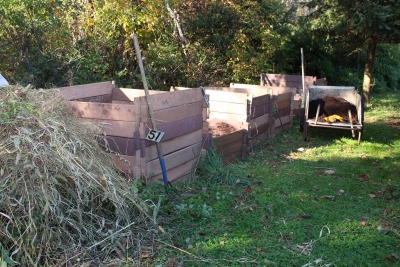Somethings Old, Somethings New, Nothing Blue
/4 Comments/in Gardening, Vegetables/by Lee ReichRare and/or Perennial
I usually draw a blank when someone asks me “So what’s new in your garden for this year?” Now, with the pressure off and nobody asking, I’m able to tell.
Of course, I often try new varieties of run of the mill vegetables and fruits. More interesting perhaps, would be something like the Noir de Pardailhan turnip. 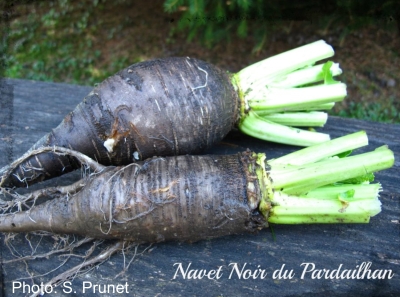 This ancient variety, elongated and with a black skin, has been grown almost exclusively near the Pardailhan region of France. Why am I growing it? The flavor is allegedly sweeter than most turnips, reminiscent of hazelnut or chestnut.
This ancient variety, elongated and with a black skin, has been grown almost exclusively near the Pardailhan region of France. Why am I growing it? The flavor is allegedly sweeter than most turnips, reminiscent of hazelnut or chestnut.
I planted Noir de Pardailhan this spring but was unimpressed with the flavor. Those mountains near Pardailhan are said to provide the terroir needed to bring out the best in this variety. (Eye roll by me. Why? See last chapter in my book The Ever Curious Gardener for the skinny on terroir.) I’ll give Noir de Pardailhan another chance with a late summer planting.
Also interesting is Nebur Der sorghum. This seeds of this variety, from South Sudan, are for popping, for boiling, and for roasting. What sorghum has going for it is that it’s a tough plant, very drought resistant and cosmopolitan about its soil. With my previous attempt with sorghum, with a different variety, the seed didn’t have time to ripen. Nate Kleinman, of the Experimental Farm Network, where I got Nebur Der seed, believes this variety may ripen this far north.
Nate also suggested some perennial vegetables to try — that’s right, vegetables you plant just once and then harvest year after year. I planted Caucasian mountain spinach (Hablitzia tamnoides), a relative of true spinach, and, as predicted, growth is slow this, its first, year. 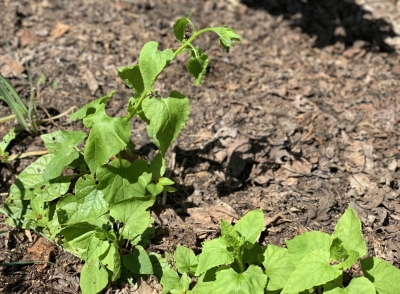 Next year I can expect a vine growing 6 to 9 feet high and which is both decorative and tolerates some shade. What’s not to like? (I’ll report back with the flavor.)
Next year I can expect a vine growing 6 to 9 feet high and which is both decorative and tolerates some shade. What’s not to like? (I’ll report back with the flavor.)
Andy’s Green Multiplier Onion (Allium cepa var. aggregatum), also from the Experimental Farm Network, will, I hope, fill that early spring gap here when some onion flavor can liven salads. 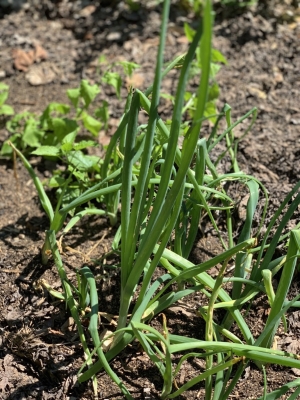 Later in the season, cluster of bulbs form, similar to shallots, although forming larger bulbs. They can overwinter and make new onion greens and bulbs the following years.
Later in the season, cluster of bulbs form, similar to shallots, although forming larger bulbs. They can overwinter and make new onion greens and bulbs the following years.
And finally, again from Nate, the New Zealand strain of perennial multiplying leek (Allium ampeloprasum). This seems to be a variable species, with some members yielding large bulbs know as elephant garlic. The flavor might vary from that of leek to that of garlic.
One more perennial plant (this one for the greenhouse so not really perennial here), is jicama (Pachyrhizus erosus), a climbing vine in the pea family. The flavor and texture of the large, turnip-shaped root is something like water chestnut. The flavor of the other parts of the plant are . . . not to be tried. All other parts are poisonous! The greenhouse is so hot in summer that I figured this is one of the few plants, besides figs and ginger, that would thrive there.
Probably not. I should have researched before planting: Jicama roots are poor quality unless the plant experiences a long period of warmth with short days. But when short days come around, my greenhouse is starting to fill with lettuce, mâche, spinach, and other fresh greenery for winter salads.
Could Be Frightening, But Not
At least one more newish crop made it into my garden this year, one that I hope is not perennial. The plant is sometimes called yellow nutsedge, sometimes chufa, and sometimes tiger nut or earth almond. When I lived in southern Delaware, “yellow nutsedge “would strike terror in the hearts of local farmers; it’s been billed as “one of the world’s worst weeds.”
But there are two botanical varieties of yellow nutsedge. That weedy one is Cyperus esculentus var. esculentus. The one that I am growing is C. esculentus var. sativus. The latter is not weedy; it rarely flowers or sets seed, and doesn’t live through the winter. Both varieties, being sedges, enjoy soils that are wet but also enjoy those that are well-drained.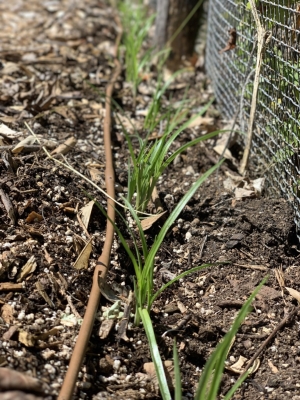
The edible part of chufa are the dime-sized tubers, which are sweet and have flavor likened to almonds. I did grow the plant once and thought the tubers tasted more like coconut. 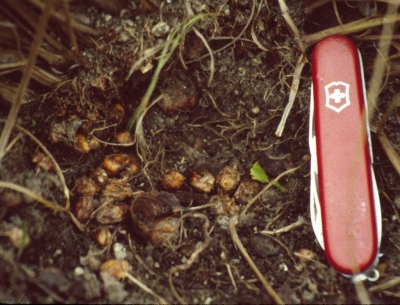 The problem was separating the small tubers from soil and small stones. I have a plan this time around — more about this at harvest time.
The problem was separating the small tubers from soil and small stones. I have a plan this time around — more about this at harvest time.
I’ll be in good company growing chufa. We humans munched on them in the Paleolithic period and they were good food to the ancient Egyptians. Hieroglyphic instructions detail the preparation of chufa for eating, as a sweet, for instance, ground and mixed with honey.
Even today, chufa is enjoyed in various parts of the world. The chufa harvest is anxiously awaited each year in Spain, when the dried tubers are washed and pulverized, then made into a sugar-sweetened “milk” know as “Horchata De Chufas.”
Last reminder for June 30, 2019 Drip Irrigation workshop
/0 Comments/in Gardening/by Lee ReichFor information and registration deadline, see www.leereich.com/workshops
My Compost for a Bin
/50 Comments/in Gardening, Planning, Soil/by Lee ReichCompost, All Good, In Time
One problem with gardening, as I see it, is that much of it is about delayed gratification. Even a radish makes you wait 3 weeks after sowing the seed before you get to chomp on it. With a pear tree, that wait is a few years.
Which brings me to compost. Now that the flurry of spring pruning and planting have subsided, I’m starting this year’s compost cycle again — that’s compost for use next year. Delayed gratification again.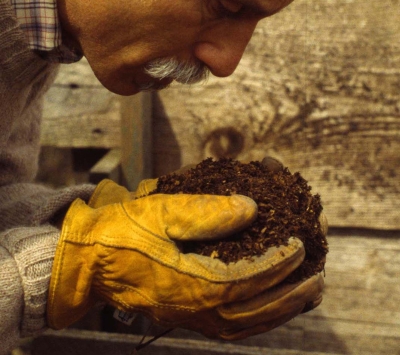
Food waste, yard waste, and compostable paper make up 31% of an average household’s waste which, if landfilled, ties up land and contributes to global warming. Composted, it feeds the soil life and, in turn, plants, and maintains soil tilth, that crumbly feel of a soil that holds on to moisture yet has plenty of space for air. You don’t get all this from a bag of 10-10-10 fertilizer or even a bag of any concentrated organic fertilizer.
The key to good composting is to have a good bin. Any pile of old vegetables, leaves, grass clippings, old cotton clothes, straw, or wood chips will turn to compost eventually. A bin keeps everything neat, fends off scavengers, and maintains heat and moisture within.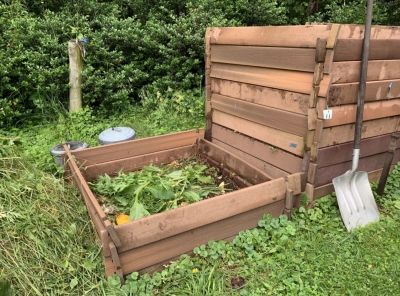
Buying a compost bin is one option. Consider whether you’re making compost for your garden or just as an environmentally sound way to recycle what used to be called “trash.” You need a larger bin for the former use because you’ll be importing materials, such as leaves, wood chips, and manure, to bulk up the compost.
The Perfect Compost Bin?
Over the years, my home made compost bins have gone through several incarnations. Four wooden panels filled in with chickenwire made my first bin. Once a pile was made and settled a little, I removed the panels, pinned black plastic onto the compost cubes to keep in moisture, and set up the panel in the next location for a new “compost cube.”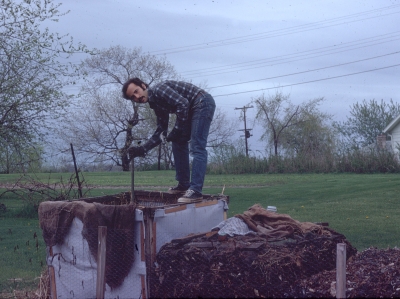 The next bins weren’t bins but just carefully stacked layers of ingredients, mostly horse manure, hay, and garden and kitchen gleanings. And then there was my three-sided bin made of slabwood.
The next bins weren’t bins but just carefully stacked layers of ingredients, mostly horse manure, hay, and garden and kitchen gleanings. And then there was my three-sided bin made of slabwood.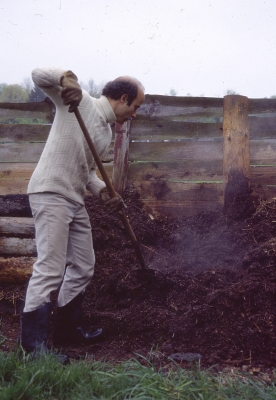
A dramatic jump in functionality came with my bin made from 1 x 12 hemlock boards from a sawmill, notched to stack together on edge like Lincoln logs. The only problem with this system was that I had to periodically purchase and notch new boards as older ones rotted away.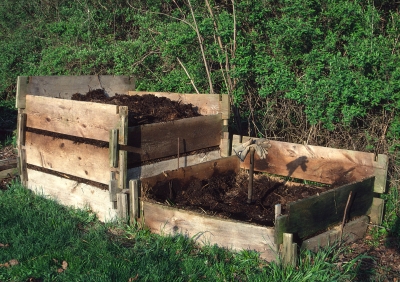 Which brings me to my current bin which, now, after many years of use, I consider nearly perfect. Instead of hemlock boards, these bins are made from “composite lumber.” Manufactured mostly from recycled materials, such as scrap wood, sawdust, and old plastic bags, composite lumber is used for decking so should last a long, long time.
Which brings me to my current bin which, now, after many years of use, I consider nearly perfect. Instead of hemlock boards, these bins are made from “composite lumber.” Manufactured mostly from recycled materials, such as scrap wood, sawdust, and old plastic bags, composite lumber is used for decking so should last a long, long time.
The boards I used were 5-1/2 inches wide and 1 inch thick. A couple of inches from either end of each 5-foot-long board, I cut a notch on each side to a depth one-quarter the width of the board and about 1/8” wider than the their thickness. When finished, I ripped one board of the bin full length down its center to provide two bottom boards so that the bottom edges of all 4 sides of the bin would sit right against on the ground.
When finished, I ripped one board of the bin full length down its center to provide two bottom boards so that the bottom edges of all 4 sides of the bin would sit right against on the ground. Before setting up a bin, I lay 1/2” hardware cloth on the ground to help keep at bay rodents that might try to crawl in from below.
Before setting up a bin, I lay 1/2” hardware cloth on the ground to help keep at bay rodents that might try to crawl in from below.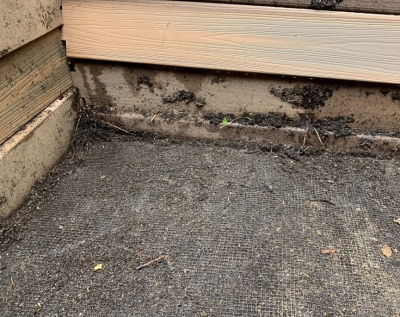 With the Lincoln-log style design, the bin need be only as high as the material within while the pile is being built, and then “unbuilt” gradually as I removed the finished compost.
With the Lincoln-log style design, the bin need be only as high as the material within while the pile is being built, and then “unbuilt” gradually as I removed the finished compost.
June 2024 update: As you might note from the photos in this post, I made lots of compost bins, actually too many. What was I thinking? I’ve now decided to sell off some of these bins. About 28 boards, each 4′ long, are needed for a completed bin. I’m selling each board for $5, so a complete bin of 28 boards would cost you $140, more or less, depending on the bin height you want. I do make lots of compost so only have a few bins to sell. Contact me if you’re interested (845-616-0710 or through my website, but not Messenger).
Feed the Beast(s)
Okay, time to feed my compost “pets.” Nothing fancy, just any spent plant from the garden, kitchen trimmings, old clothes made from natural materials, hay scythed from my meadow, horse manure from a local stable, and occasional sprinklings of soil and powdered limestone.
For interest, I’ll sometimes throw old shoes or gloves into a pile to see what’s left once the organic portion of the shoe or glove has been stripped off.By paying attention to the textures of the materials as I add them to the pile, it generally stays well aerated. If I have a load of manure and will be building up many layers of the pile at once, I water the layers as I go; it takes too long to get sufficient water down into the pile after it has been built. Once a pile is completed, I cover it with a layer of EPDM rubber roofing material, cut to fit, to seal in moisture and keep out rain.
Piles built this summer get turned once next spring so I can monitor progress and make sure they’re moist — but not too wet — throughout. The compost is used throughout next year’s growing season.
So yes, there is delayed gratification before I get to use the “black gold.” Then again, making compost is enjoyable; I get some exercise and enjoy feeding the various fungi, bacteria, and other microorganisms at work in the compost pile.